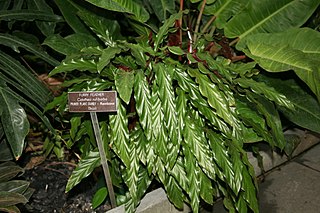Goeppertia curaraya is a species of flowering plant in the Marantaceae family. It is native to Ecuador and Colombia. Its natural habitat is subtropical or tropical moist lowland forests.
Goeppertia dodsonii is a species of flowering plant in the Marantaceae family. It is endemic to Ecuador. Its natural habitat is subtropical or tropical moist lowland forests.

Goeppertia ecuadoriana is a species of flowering plant in the Marantaceae family. It is endemic to Ecuador. Its natural habitats are subtropical or tropical moist lowland forests and subtropical or tropical moist montane forests.
Goeppertia gandersii is a species of flowering plant in the Marantaceae family. It is endemic to Napo Province of Ecuador. Its natural habitats are subtropical or tropical moist lowland forests and subtropical or tropical moist montane forests.
Goeppertia libbyana is a species of flowering plant in the family Marantaceae, endemic to Napo Province of Ecuador. Its natural habitat is subtropical or tropical moist lowland forests. It has gained the Royal Horticultural Society's Award of Garden Merit.

Goeppertia veitchiana is a species of flowering plant in the Marantaceae family. It is endemic to Ecuador. Its natural habitats are subtropical or tropical moist lowland forests and subtropical or tropical moist montane forests.

Goeppertia makoyana, also known as peacock plant or cathedral windows, is a species of plant belonging to the genus Goeppertia in the family Marantaceae, native to Espírito Santo state of eastern Brazil. It has gained the Royal Horticultural Society's Award of Garden Merit.

Goeppertia loeseneri, the Brazilian star calathea, is a species of plant belonging to the Marantaceae family. It is native to Peru, northern Brazil, Colombia, and Ecuador. It can grow to a height of 1.2m.

Goeppertia is a genus of flowering plants in the family Marantaceae, native to the New World Tropics. It contains 243 accepted species, many of which were until recently assigned to Calathea. It was first described by Nees von Esenbeck in 1831, who erroneously erected another genus Goeppertia in 1836, which has now been synonymized with Endlicheria. In 1862 August Grisebach described another genus Goeppertia; this has now been synonymized with Bisgoeppertia.

Goeppertia rufibarba, the furry feather or velvet calathea, is a species of flowering plant in the Marantaceae family, native to Bahia state of northeastern Brazil. The plant's common names are due to its fuzzy, fur-like underleaf texture, which is unusual in its genus. Common as a houseplant, the species requires warm temperatures, shade, and humidity to thrive, and may produce small yellow flowers. It has gained the Royal Horticultural Society's Award of Garden Merit.

Goeppertia roseopicta is a species of flowering plant in the arrowroot and prayer-plant family Marantaceae, native to northwestern Brazil's Amazonian basin. Oftentimes, it is marketed as a houseplant under its former generic name and synonym Calathea roseopicta. It is a clump-forming, evergreen perennial, growing to 50 cm (20 in), and is very similar in appearance to G. makoyana. The typical "wild-type", or "natural" form, has papery, ovate leaves of a pastel, seafoam-green hue, outlined with a dark-green edging and "painted" horizontally from the midribs with darker streaks; typical of other species in its family and genus, G. roseopicta features dark reddish, purplish backsides to its foliage, an evolutionary adaptation to growing in darkened or shaded areas on the forest floor, where adequate light reflection is required for photosynthesis.

Goeppertia crocata, the saffron-coloured calathea or eternal flame plant, is a species of flowering plant in the family Marantaceae, native to Bahia and Espírito Santo states of eastern Brazil. It has gained the Royal Horticultural Society's Award of Garden Merit as a hothouse ornamental.

Goeppertia majestica, the majestic prayer plant, is a species of flowering plant in the family Marantaceae. It is native to Colombia, Ecuador, Peru, Bolivia, Guyana, and northern Brazil, and has been introduced to Venezuela. A large member of its genus, it has gained the Royal Horticultural Society's Award of Garden Merit.
Goeppertia mediopicta, the middle-stripe prayer plant, is a species of flowering plant in the family Marantaceae, native to Espírito Santo state in southeastern Brazil. It has gained the Royal Horticultural Society's Award of Garden Merit.

Goeppertia fasciata, is a species of flowering plant in the family Marantaceae. Native to wet tropical areas of northeastern Brazil, it is occasionally kept as a houseplant. There appears to be a cultivar, 'Borrusica'.

Goeppertia cylindrica is a species of plant in the Marantaceae family. It is native to eastern and central Brazil.

Goeppertia burle-marxii is a species of plant in the Marantaceae family native to Brazil. It is named after Roberto Burle Marx. Common names for Goeppertia burle-marxii include "Blue Ice Calathea" and "White Ice Calathea".
Goeppertia chimboracensis is an endangered species of flowering plant in the Marantaceae family. It is endemic to Ecuador.

Goeppertia latifolia is a species of plant in the family Marantaceae. Its native range is Panama to Ecuador and Trinidad. It is used as a food and medicine. Prehistoric Lucayan migrants to the Bahamas brought Goeppertia latifolia with them from their ancestral homelands. The flowers of Goeppertia latifolia do not open spontaneously.
Goeppertia sanderiana is a species of plant in the family Marantaceae. Its native range is northern Peru, and it has been introduced to El Salvador and Honduras. It is used in horticulture for its foliage.












